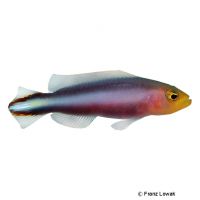Double Striped Dottyback (Pseudochromis bitaeniatus)
| Double Striped Dottyback Pseudochromis bitaeniatus | |
|---|---|
| Name | Double Striped Dottyback |
| Name Lat. | Pseudochromis bitaeniatus |
| Family | Dottybacks |
| Family lat. | Pseudochromidae |
| Order | Ovalentarias |
| Order lat. | Ovalentaria inc. sed. |
| Origin | Western Pacific |
| Habitat | Coral reefs |
| Diet | Carnivore |
| pH | 8.1-8.4 |
| Hardness | 8-10 °KH |
| Behavior | Semi-aggressive |
| Keeping | Individual, pair |
| Reef Compatible | Yes |
| Care Level | Easy |
| Life Span | 2-5 years |
| Protection | No |
| Metric Units | |
| Size | 12 cm |
| Temperature | 24-28 °C |
| Salinity | 33-36 ‰ |
| Aquarium | ~ 200 l |
| US Units | |
| Size | 5" |
| Temperature | 75-82 °F |
| Salinity | 1.020-1.025 sg |
| Aquarium | ~ 50 gal |
Distribution and habitat
The distribution area of Pseudochromis bitaeniatus is the Western Pacific, from the Philippines to North Queensland (Australia). They live in small caves and among corals on the slopes of coral-rich coastal reefs at 2-38 m depth.
Maintenance
They require a well-structured aquarium with a reef structure (branching coral sticks, small caves and crevices) and live stones that act like a biological filter, as well as fine-grained sandy areas. Only lime-rich, heavy metal-free sands, gravels, stones or sea sand of various grain sizes may be used as substrate
Filters, skimmers and heaters are necessary to ensure water quality, as well as pumps to simulate tides, swells and bottom currents. Lighting must correspond to the species-appropriate day-night rhythm of the animals
| Salinity: 33-36 ‰ | pH value: 8.1-8.4 |
| Carbonate hardness: 8-10 °KH | Nitrate content: 2-8 mg/l |
| phosphate content: 0.01-0.1 mg/l | nitrite content: 0.0-0.05 mg/l |
For salinity, an average value should be aimed for, which may only vary slightly by +/- 0.5 ‰. Ammonia and ammonium must not be measurable. Special attention must be paid to consistently good water quality and water values.
Diet
They are ambush hunters that prefer to eat planktonic small crustaceans. The food change usually succeeds without problems. The food supply should consist of a combination of live and frozen food, such as artemia, mysis, shrimp and krill, with chopped fish, mussel and shrimp meat or a commercially available frozen food mixture enriched with vitamins. Dry food (flakes, granules) is rarely accepted
It is recommended to feed small portions several times a day. Regular and varied feeding promotes health and increases resistance.
Behaviour and compatibility
They are very territorial and even when pairs are formed, each animal often occupies its own territory, which is vigorously defended. The dominant, usually somewhat larger animal always has male status. To avoid territorial fights, they should be introduced into the aquarium at the same time. Group keeping is only possible in a larger aquarium with many hiding places. Towards other fishes they behave mostly peacefully.
Sex dimorphism
They are protogynous hermaphrodites, i.e. most males develop from functional females. No external distinguishing characteristics are known.
Reproduction and breeding
There are no known reports of successful breeding in the aquarium.
Important
They hardly swim in the open water, but stay close to their hiding place, to which they retreat in a flash in case of danger. Care should be taken when keeping them together with shrimp. As coral reef dwellers, they should not be kept in a fish-only aquarium.
If different species are kept together, care should be taken to ensure that the fish match each other in terms of water quality and temperature requirements and social behavior, and that the setup meets the needs of all species kept together. New fish to be introduced must be acclimated slowly to the water in the aquarium.
Further literature can be found in your pet store.
References
Text: Werner Winter; Image: Franz Lowak
Source: KUITER & DEBELIUS (2007): Atlas der Meeresfische: Die Fische an den Küsten der Weltmeere, Kosmos Verlag; ENGELMANN (2005): Zootierhaltung - Tiere in menschlicher Obhut: Fische, Verlag Harri Deutsch
- Gemäß § 21 Abs. 5 Tierschutzgesetz idgF
